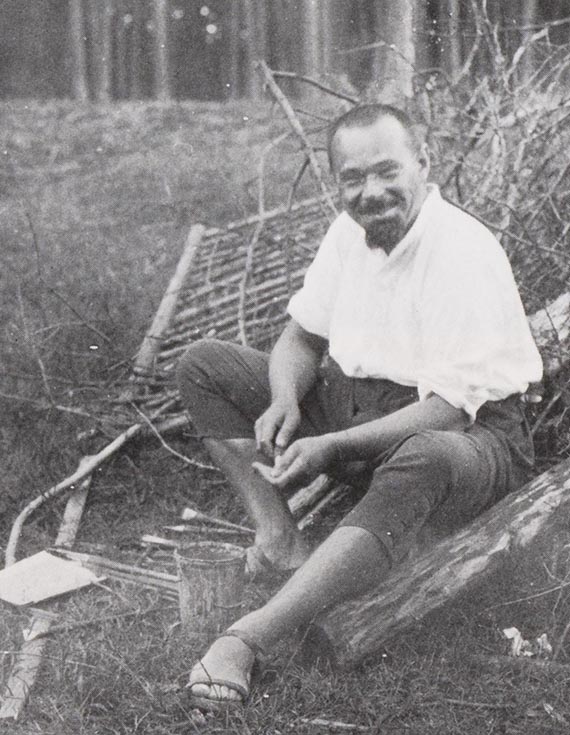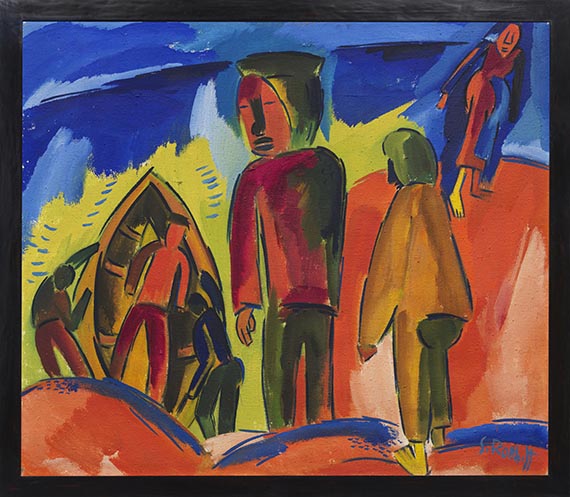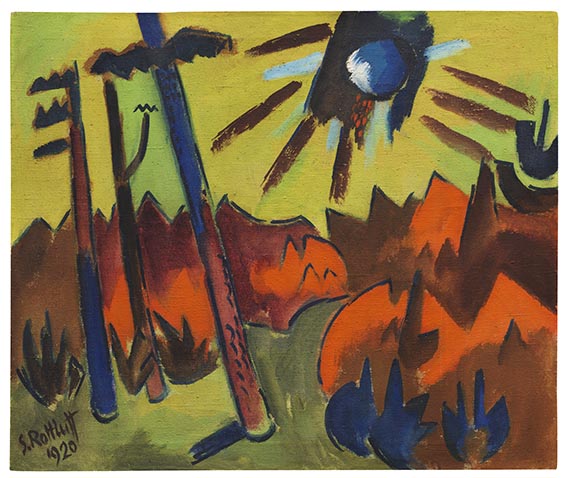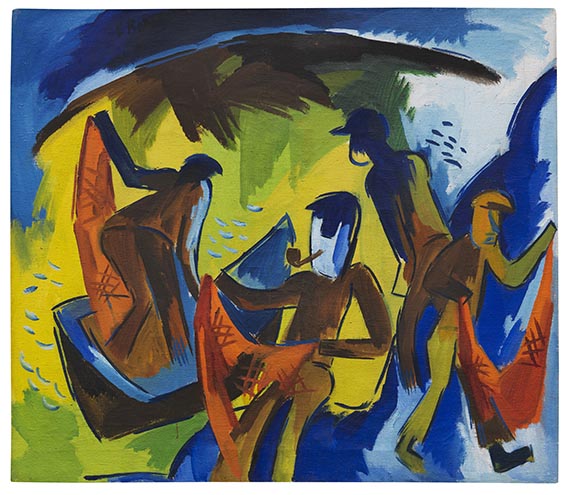19
Karl Schmidt-Rottluff
Fischer auf der Düne, 1921.
Oil on canvas
Estimate:
€ 400,000 - 600,000
$ 440,000 - 660,000
Fischer auf der Düne. 1921.
Oil on canvas.
Signed in the lower right. Signed, titled and inscribed with the work number “213” on the reverse of the stretcher. Once more inscribed with the work number on the reverse of the partially overpainted canvas. 87.5 x 100.5 cm (34.4 x 39.5 in). [CH].
• Expressionism in its purest form: bright red figures against a deep blue sky and radiant yellow reflections of the sun.
• Jershöft, a place of inspiration: Fascinated with the simple life he found there, Schmidt-Rottluff spent many summers on the Baltic Sea from 1920.
• In his observations of people and nature, the artist found new confidence in color.
• Paintings by the artist of this outstanding quality and vibrancy are scarce on the auction market.
• Part of the outstanding collection of Berthold and Else Beitz, Essen, for 65 years.
PROVENANCE: Ferdinand Möller Collection, Berlin (presumably acquired directly from the artist in 1922).
Detroit Institute of Arts, Detroit/Michigan (taken on loan from the ownership of the above in March 1938, confiscated as “enemy property” by the American state in December 1940).
US state property (1950-1957, assumption of ownership of the above-mentioned confiscation on October 30, 1950 by “Vesting Order 15411” issued by the Office of Alien Property at the Department of Justice).
Maria Möller-Garny, Cologne (acquired in 1957 by “re-purchase” from the American government).
Angelika Fessler-Möller, Cologne (from the above)
Berthold and Else Beitz collection, Essen (acquired from the above through Galerie Grosshennig, Düsseldorf, in 1959).
Ever since in family ownership.
EXHIBITION: Neue Kunst Hans Goltz, Munich (with a fragmentary label on the reverse of the stretcher).
Touring exhibition Schmidt-Rottluff, Galerie Möller Berlin, Museum Königsberg, Museum Danzig, 1928/29 (no catalog).
Kunstwerke aus drei Jahrtausenden gesammelt im Ruhrgebiet, Kunsthalle Recklingshausen, May 16 - July 16, 1963, cat. no. 212 (illustrated).
Pommersches Landesmuseum, Greifswald (permanent loan, 2015-2024)
Zwei Männer – ein Meer. Pechstein und Schmidt-Rottluff an der Ostsee, Pommersches Landesmuseum, Greifswald, March 29 - June 28, 2015, cat. no. 9 (dated 1920, illustrated on p. 81).
LITERATURE: Will Grohmann, Karl Schmidt-Rottluff, Stuttgart 1956, p. 266 (illustrated in b/w) and p. 292.
- -
Galerie Wilhelm Grosshennig (ed.), 10 Jahre Kunsthandel in Düsseldorf 1951-1961, Düsseldorf 1961, p. (illustrated, with the incorrect date “1920”).
Eberhard Roters, Galerie Ferdinand Möller: die Geschichte einer Galerie für Moderne Kunst in Deutschland 1917-1956, Berlin 1984, pp. 156 and 226.
Katrin Engelhardt, Ferdinand Möller und seine Galerie. Ein Kunsthändler in Zeiten historischer Umbrüche, PhD thesis, Hamburg 2013, https://ediss.sub.uni-hamburg.de/bitstream/ediss/5203/1/Dissertation.pdf, p. 122, note 337.
ARCHIVE MATERIAL (selection):
File card for the art collection of Galerie Ferdinand Möller (“Fischer auf der Düne, Öl auf Leinwand” by Karl Schmidt-Rottluff), in: file cards boxes, Berlinische Galerie Berlin, Ferdinand Möller estate, BG-KA-N/F.Möller-KK.
Business correspondence between Galerie Ferdinand Möller and the Art Collections of the Free City of Danzig, Berlinische Galerie Berlin, Ferdinand Möller Estate, BG-GFM-C, II 1, 587f.
Business correspondence between Galerie Ferdinand Möller and Dr. Wilhelm Reinhold Valentiner, director of the Detroit Institute of Arts, Detroit (USA), Berlinische Galerie Berlin, Ferdinand Möller Estate, BG-GFM-C, II 1,115 (among others).
Customs invoice and customs declaration for the import of 18 oil paintings from Galerie Ferdinand Möller to the Detroit Institute of Arts, 1938, Berlinische Galerie Berlin, Ferdinand Möller Estate, BG-KA-N/F.Möller-66-M66,18-23.
Department of Justice, Office of Alien Property, Washington D.C. and others: Purchase agreement between the Office of Alien Property of the U.S. Department of Justice and Maria Möller-Garny regarding the repurchase of 19 paintings stored at the Detroit Institute of Arts, Berlinische Galerie Berlin, Ferdinand Möller Estate, BG-KA-N/F.Möller-68-M68,88-89.
Roman Zieglgänsberger, curator for Modern Art, Museum Wiesbaden, quoted in: ex. cat. Karl Schmidt-Rottluff. Landschaft, Figur, Stillleben, Brücke-Museum, Berlin, 2014/2015, p. 96.
Called up: December 6, 2024 - ca. 17.36 h +/- 20 min.
Oil on canvas.
Signed in the lower right. Signed, titled and inscribed with the work number “213” on the reverse of the stretcher. Once more inscribed with the work number on the reverse of the partially overpainted canvas. 87.5 x 100.5 cm (34.4 x 39.5 in). [CH].
• Expressionism in its purest form: bright red figures against a deep blue sky and radiant yellow reflections of the sun.
• Jershöft, a place of inspiration: Fascinated with the simple life he found there, Schmidt-Rottluff spent many summers on the Baltic Sea from 1920.
• In his observations of people and nature, the artist found new confidence in color.
• Paintings by the artist of this outstanding quality and vibrancy are scarce on the auction market.
• Part of the outstanding collection of Berthold and Else Beitz, Essen, for 65 years.
PROVENANCE: Ferdinand Möller Collection, Berlin (presumably acquired directly from the artist in 1922).
Detroit Institute of Arts, Detroit/Michigan (taken on loan from the ownership of the above in March 1938, confiscated as “enemy property” by the American state in December 1940).
US state property (1950-1957, assumption of ownership of the above-mentioned confiscation on October 30, 1950 by “Vesting Order 15411” issued by the Office of Alien Property at the Department of Justice).
Maria Möller-Garny, Cologne (acquired in 1957 by “re-purchase” from the American government).
Angelika Fessler-Möller, Cologne (from the above)
Berthold and Else Beitz collection, Essen (acquired from the above through Galerie Grosshennig, Düsseldorf, in 1959).
Ever since in family ownership.
EXHIBITION: Neue Kunst Hans Goltz, Munich (with a fragmentary label on the reverse of the stretcher).
Touring exhibition Schmidt-Rottluff, Galerie Möller Berlin, Museum Königsberg, Museum Danzig, 1928/29 (no catalog).
Kunstwerke aus drei Jahrtausenden gesammelt im Ruhrgebiet, Kunsthalle Recklingshausen, May 16 - July 16, 1963, cat. no. 212 (illustrated).
Pommersches Landesmuseum, Greifswald (permanent loan, 2015-2024)
Zwei Männer – ein Meer. Pechstein und Schmidt-Rottluff an der Ostsee, Pommersches Landesmuseum, Greifswald, March 29 - June 28, 2015, cat. no. 9 (dated 1920, illustrated on p. 81).
LITERATURE: Will Grohmann, Karl Schmidt-Rottluff, Stuttgart 1956, p. 266 (illustrated in b/w) and p. 292.
- -
Galerie Wilhelm Grosshennig (ed.), 10 Jahre Kunsthandel in Düsseldorf 1951-1961, Düsseldorf 1961, p. (illustrated, with the incorrect date “1920”).
Eberhard Roters, Galerie Ferdinand Möller: die Geschichte einer Galerie für Moderne Kunst in Deutschland 1917-1956, Berlin 1984, pp. 156 and 226.
Katrin Engelhardt, Ferdinand Möller und seine Galerie. Ein Kunsthändler in Zeiten historischer Umbrüche, PhD thesis, Hamburg 2013, https://ediss.sub.uni-hamburg.de/bitstream/ediss/5203/1/Dissertation.pdf, p. 122, note 337.
ARCHIVE MATERIAL (selection):
File card for the art collection of Galerie Ferdinand Möller (“Fischer auf der Düne, Öl auf Leinwand” by Karl Schmidt-Rottluff), in: file cards boxes, Berlinische Galerie Berlin, Ferdinand Möller estate, BG-KA-N/F.Möller-KK.
Business correspondence between Galerie Ferdinand Möller and the Art Collections of the Free City of Danzig, Berlinische Galerie Berlin, Ferdinand Möller Estate, BG-GFM-C, II 1, 587f.
Business correspondence between Galerie Ferdinand Möller and Dr. Wilhelm Reinhold Valentiner, director of the Detroit Institute of Arts, Detroit (USA), Berlinische Galerie Berlin, Ferdinand Möller Estate, BG-GFM-C, II 1,115 (among others).
Customs invoice and customs declaration for the import of 18 oil paintings from Galerie Ferdinand Möller to the Detroit Institute of Arts, 1938, Berlinische Galerie Berlin, Ferdinand Möller Estate, BG-KA-N/F.Möller-66-M66,18-23.
Department of Justice, Office of Alien Property, Washington D.C. and others: Purchase agreement between the Office of Alien Property of the U.S. Department of Justice and Maria Möller-Garny regarding the repurchase of 19 paintings stored at the Detroit Institute of Arts, Berlinische Galerie Berlin, Ferdinand Möller Estate, BG-KA-N/F.Möller-68-M68,88-89.
Roman Zieglgänsberger, curator for Modern Art, Museum Wiesbaden, quoted in: ex. cat. Karl Schmidt-Rottluff. Landschaft, Figur, Stillleben, Brücke-Museum, Berlin, 2014/2015, p. 96.
Called up: December 6, 2024 - ca. 17.36 h +/- 20 min.
Jershöft, a place of inspiration
Arriving from Berlin in the summer of 1920, Schmidt-Rottluff visited the quaint fishing village of Jershöft in Pomerania on the Baltic Sea for the first time. The village's striking landmark is a lighthouse built in 1865. The brick tower impresses with its 35-meter height.
The fishing village, which he would visit over the summers of the coming years until 1931, was a peaceful oasis in the turbulent post-war years for the artist, especially in the light of political struggles between extremist groups in the fledgling Weimar Republic, especially in his home city of Berlin. Schmidt-Rottluff devoted much of his work to rural life. His subjects were fishermen, farmers, artisans, and laborers, who, through their daily work, were at one with the landscape, inspiring the artist to create these energetic works.

Depictions of rural life
Special mention should be made of the painting "Fischer auf der Düne" (Fishermen on the Dune), a key work in the pictures showing workers and craftsmen. Schmidt-Rottluff's efforts to attain monumentality with a highly dynamic painting style become tangible. Generous, simplified forms and large color zones determine the character of the composition, a multifaceted landscape with cliffs and dunes. Schmidt-Rottluff captured the outlines of figures and objects, such as the boat, with rapid, almost sketchy brushstrokes. The contours are almost always rendered in black. The color takes on a vibrant, luminous life within the surface-determining boundaries. It is always this sublime use of color, the substantial, deep blue so typical of Schmidt-Rottluff, in contrast to olive ocher and reddish brown, that is now used preferentially and blended into a harmonious whole. The fishermen and the boat occasionally take on sculptural forms, and the artist uses rhythmic shapes and color fields that extend beyond their contours to assimilate the figures of the fishermen into the landscape. The textural treatment of color, the rich application of paint, and the solid forms bounded by contours make the work so compelling. Here, figures and objects have a somewhat arbitrary appearance, morphing into a colored surface painting that brings new momentum to his art and allows it to intensify its expressiveness.

Radiant colors and vibrant surfaces
In the Jershöft paintings, Schmidt-Rottluff evolved a colorful, flat style of painting that gave his art an overwhelming expression. Zones of pure color intertwine, infusing the surface with a dynamic rhythm. Occasionally, the forms seem to dissolve into an almost abstract color field, although their relationship to the actual motif is always preserved. The artist also uses black contours to define distinct shapes, creating a sense of space due to the arrangement of the individual pictorial elements. The artist describes the fishermen's chores in “Fischer auf der Düne” and their hard work in any weather. Schmidt-Rottluff shows people in expressive movement devoid of the usual physiognomy; these gestures appear for the first time in his works. Nevertheless, an echo of the expressive style of the pre-war period remains in Karl Schmidt-Rottluff's works in the post-war years, although they inspire a much more emotional, less tranquil impression. In the present painting, Schmidt-Rottluff achieved a high degree of formal and chromatic abstraction without losing touch with the visible. In his monograph and catalogue raisonné of Schmidt-Rottluff's work, published in 1956, Will Grohmann, an expert on the artist, characterizes the works created between 1921 and 1923 in the chapter entitled “Color Field and Zone Painting” (Grohmann, Karl Schmidt-Rottluff, Stuttgart 1956, p. 106).
Fascinating provenance
The art dealer Ferdinand Möller presumably purchased the painting shortly after it was created. Möller, actually a bookseller, began his incredibly successful career in 1912 at the famous Galerie Arnold in Dresden; the then owner Ludwig Gutbier had organized the landmark exhibition of the “Brücke” artists in 1910. In 1913, Möller founded a branch of the Arnold Gallery in Wroclaw, and in October 1918, he opened his own gallery on Potsdamer Strasse in Berlin. The artists he represented included Erich Heckel, Ernst Ludwig Kirchner, Otto Mueller, Emil Nolde, Karl Schmidt-Rottluff, and others. Like many other paintings by the “Brücke” group, “Fischer auf der Düne” remained in the gallery's possession. In July 1937, the infamous exhibition 'Degenerate Art' opened in Munich; the artworks confiscated from museums were finally legally expropriated on May 1, 1938. In response, Möller gave 19 works, including our painting, to his friend Wilhelm R. Valentiner in Detroit on loan. The German-American art historian had been the Detroit Art Institute director since 1924 and published the first monograph on Karl Schmidt-Rottluff as early as 1920. By the “Vesting Order” of the Department of Justice, Office of Alien Property of October 30, 1950, Möller's collection was confiscated as “enemy property” and taken over as property of the US government. After long and arduous negotiations – Ferdinand Möller died in January 1956 – 17 of the paintings that had initially been sent as loans finally arrived in Cologne, where the gallery had been based since 1951, in January 1958. The family donated two paintings, “Bild mit weißer Form” (1913) by Wassily Kandinsky and “Grüne Brücke” (1916) by Lyonel Feininger, to the Detroit Art Institute and the North Carolina Museum of Arts in Raleigh as a form of compensation. In the end, the painting “Fischer auf der Düne” became part of the renowned Berthold and Else Beitz Collection, Essen, through the agency of the art dealer Wilhelm Grosshennig, who was originally from Chemnitz but settled in Düsseldorf after the GDR had been proclaimed. [MvL]
Arriving from Berlin in the summer of 1920, Schmidt-Rottluff visited the quaint fishing village of Jershöft in Pomerania on the Baltic Sea for the first time. The village's striking landmark is a lighthouse built in 1865. The brick tower impresses with its 35-meter height.
The fishing village, which he would visit over the summers of the coming years until 1931, was a peaceful oasis in the turbulent post-war years for the artist, especially in the light of political struggles between extremist groups in the fledgling Weimar Republic, especially in his home city of Berlin. Schmidt-Rottluff devoted much of his work to rural life. His subjects were fishermen, farmers, artisans, and laborers, who, through their daily work, were at one with the landscape, inspiring the artist to create these energetic works.

Karl Schmidt-Rottluff in Jershöft, 1921.
Depictions of rural life
Special mention should be made of the painting "Fischer auf der Düne" (Fishermen on the Dune), a key work in the pictures showing workers and craftsmen. Schmidt-Rottluff's efforts to attain monumentality with a highly dynamic painting style become tangible. Generous, simplified forms and large color zones determine the character of the composition, a multifaceted landscape with cliffs and dunes. Schmidt-Rottluff captured the outlines of figures and objects, such as the boat, with rapid, almost sketchy brushstrokes. The contours are almost always rendered in black. The color takes on a vibrant, luminous life within the surface-determining boundaries. It is always this sublime use of color, the substantial, deep blue so typical of Schmidt-Rottluff, in contrast to olive ocher and reddish brown, that is now used preferentially and blended into a harmonious whole. The fishermen and the boat occasionally take on sculptural forms, and the artist uses rhythmic shapes and color fields that extend beyond their contours to assimilate the figures of the fishermen into the landscape. The textural treatment of color, the rich application of paint, and the solid forms bounded by contours make the work so compelling. Here, figures and objects have a somewhat arbitrary appearance, morphing into a colored surface painting that brings new momentum to his art and allows it to intensify its expressiveness.

Karl Schmidt-Rottluff, Fischersonntag, 1923, oil on canvas, Brücke-Museum Berlin.
© VG Bild-Kunst, Bonn 2024
© VG Bild-Kunst, Bonn 2024
Radiant colors and vibrant surfaces
In the Jershöft paintings, Schmidt-Rottluff evolved a colorful, flat style of painting that gave his art an overwhelming expression. Zones of pure color intertwine, infusing the surface with a dynamic rhythm. Occasionally, the forms seem to dissolve into an almost abstract color field, although their relationship to the actual motif is always preserved. The artist also uses black contours to define distinct shapes, creating a sense of space due to the arrangement of the individual pictorial elements. The artist describes the fishermen's chores in “Fischer auf der Düne” and their hard work in any weather. Schmidt-Rottluff shows people in expressive movement devoid of the usual physiognomy; these gestures appear for the first time in his works. Nevertheless, an echo of the expressive style of the pre-war period remains in Karl Schmidt-Rottluff's works in the post-war years, although they inspire a much more emotional, less tranquil impression. In the present painting, Schmidt-Rottluff achieved a high degree of formal and chromatic abstraction without losing touch with the visible. In his monograph and catalogue raisonné of Schmidt-Rottluff's work, published in 1956, Will Grohmann, an expert on the artist, characterizes the works created between 1921 and 1923 in the chapter entitled “Color Field and Zone Painting” (Grohmann, Karl Schmidt-Rottluff, Stuttgart 1956, p. 106).
Fascinating provenance
The art dealer Ferdinand Möller presumably purchased the painting shortly after it was created. Möller, actually a bookseller, began his incredibly successful career in 1912 at the famous Galerie Arnold in Dresden; the then owner Ludwig Gutbier had organized the landmark exhibition of the “Brücke” artists in 1910. In 1913, Möller founded a branch of the Arnold Gallery in Wroclaw, and in October 1918, he opened his own gallery on Potsdamer Strasse in Berlin. The artists he represented included Erich Heckel, Ernst Ludwig Kirchner, Otto Mueller, Emil Nolde, Karl Schmidt-Rottluff, and others. Like many other paintings by the “Brücke” group, “Fischer auf der Düne” remained in the gallery's possession. In July 1937, the infamous exhibition 'Degenerate Art' opened in Munich; the artworks confiscated from museums were finally legally expropriated on May 1, 1938. In response, Möller gave 19 works, including our painting, to his friend Wilhelm R. Valentiner in Detroit on loan. The German-American art historian had been the Detroit Art Institute director since 1924 and published the first monograph on Karl Schmidt-Rottluff as early as 1920. By the “Vesting Order” of the Department of Justice, Office of Alien Property of October 30, 1950, Möller's collection was confiscated as “enemy property” and taken over as property of the US government. After long and arduous negotiations – Ferdinand Möller died in January 1956 – 17 of the paintings that had initially been sent as loans finally arrived in Cologne, where the gallery had been based since 1951, in January 1958. The family donated two paintings, “Bild mit weißer Form” (1913) by Wassily Kandinsky and “Grüne Brücke” (1916) by Lyonel Feininger, to the Detroit Art Institute and the North Carolina Museum of Arts in Raleigh as a form of compensation. In the end, the painting “Fischer auf der Düne” became part of the renowned Berthold and Else Beitz Collection, Essen, through the agency of the art dealer Wilhelm Grosshennig, who was originally from Chemnitz but settled in Düsseldorf after the GDR had been proclaimed. [MvL]
19
Karl Schmidt-Rottluff
Fischer auf der Düne, 1921.
Oil on canvas
Estimate:
€ 400,000 - 600,000
$ 440,000 - 660,000
Buyer's premium, taxation and resale right compensation for Karl Schmidt-Rottluff "Fischer auf der Düne"
This lot can be purchased subject to differential or regular taxation, artist‘s resale right compensation is due.
Differential taxation:
Hammer price up to 800,000 €: herefrom 32 % premium.
The share of the hammer price exceeding 800,000 € is subject to a premium of 27 % and is added to the premium of the share of the hammer price up to 800,000 €.
The share of the hammer price exceeding 4,000,000 € is subject to a premium of 22 % and is added to the premium of the share of the hammer price up to 4,000,000 €.
The buyer's premium contains VAT, however, it is not shown.
Regular taxation:
Hammer price up to 800,000 €: herefrom 27 % premium.
The share of the hammer price exceeding 800,000 € is subject to a premium of 21% and is added to the premium of the share of the hammer price up to 800,000 €.
The share of the hammer price exceeding 4,000,000 € is subject to a premium of 15% and is added to the premium of the share of the hammer price up to 4,000,000 €.
The statutory VAT of currently 19 % is levied to the sum of hammer price and premium. As an exception, the reduced VAT of 7 % is added for printed books.
We kindly ask you to notify us before invoicing if you wish to be subject to regular taxation.
Calculation of artist‘s resale right compensation:
For works by living artists, or by artists who died less than 70 years ago, a artist‘s resale right compensation is levied in accordance with Section 26 UrhG:
4 % of hammer price from 400.00 euros up to 50,000 euros,
another 3 % of the hammer price from 50,000.01 to 200,000 euros,
another 1 % for the part of the sales proceeds from 200,000.01 to 350,000 euros,
another 0.5 % for the part of the sale proceeds from 350,000.01 to 500,000 euros and
another 0.25 % of the hammer price over 500,000 euros.
The maximum total of the resale right fee is EUR 12,500.
The artist‘s resale right compensation is VAT-exempt.
Differential taxation:
Hammer price up to 800,000 €: herefrom 32 % premium.
The share of the hammer price exceeding 800,000 € is subject to a premium of 27 % and is added to the premium of the share of the hammer price up to 800,000 €.
The share of the hammer price exceeding 4,000,000 € is subject to a premium of 22 % and is added to the premium of the share of the hammer price up to 4,000,000 €.
The buyer's premium contains VAT, however, it is not shown.
Regular taxation:
Hammer price up to 800,000 €: herefrom 27 % premium.
The share of the hammer price exceeding 800,000 € is subject to a premium of 21% and is added to the premium of the share of the hammer price up to 800,000 €.
The share of the hammer price exceeding 4,000,000 € is subject to a premium of 15% and is added to the premium of the share of the hammer price up to 4,000,000 €.
The statutory VAT of currently 19 % is levied to the sum of hammer price and premium. As an exception, the reduced VAT of 7 % is added for printed books.
We kindly ask you to notify us before invoicing if you wish to be subject to regular taxation.
Calculation of artist‘s resale right compensation:
For works by living artists, or by artists who died less than 70 years ago, a artist‘s resale right compensation is levied in accordance with Section 26 UrhG:
4 % of hammer price from 400.00 euros up to 50,000 euros,
another 3 % of the hammer price from 50,000.01 to 200,000 euros,
another 1 % for the part of the sales proceeds from 200,000.01 to 350,000 euros,
another 0.5 % for the part of the sale proceeds from 350,000.01 to 500,000 euros and
another 0.25 % of the hammer price over 500,000 euros.
The maximum total of the resale right fee is EUR 12,500.
The artist‘s resale right compensation is VAT-exempt.




 Lot 19
Lot 19 


